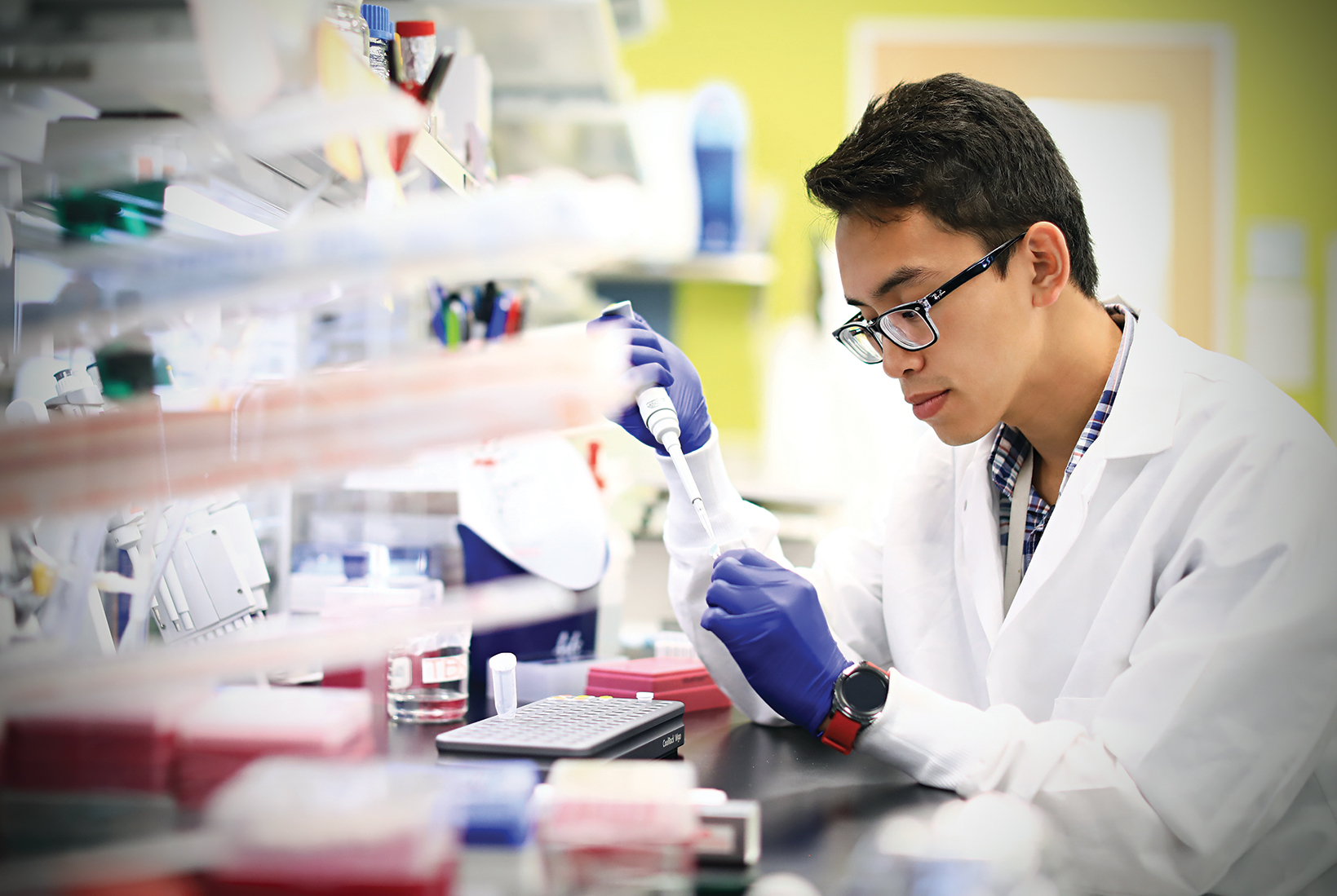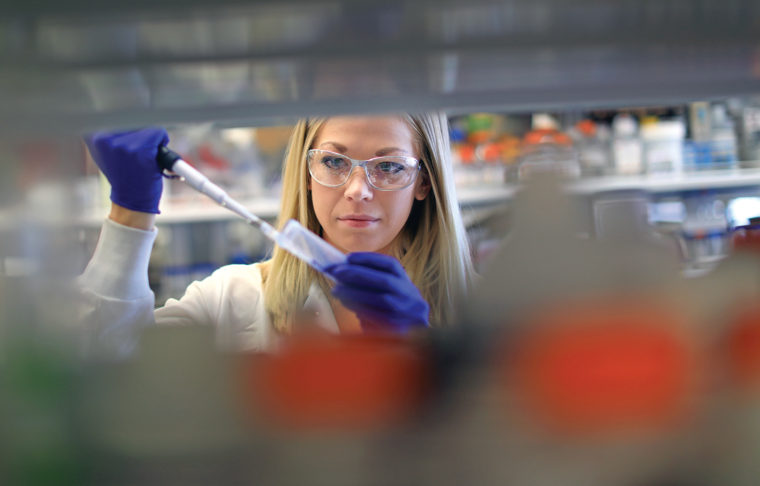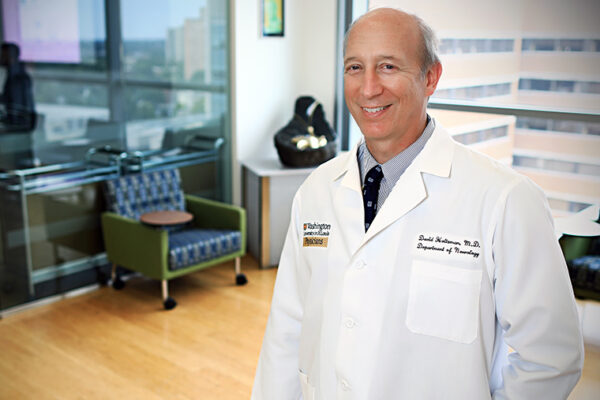At Washington University, training the next generation of leaders in translational medicine is a key focus. “The young people in our labs are smart and dedicated, and they know that what we’re doing will change medicine — 20 years, 10 years, 5 years from now,” Skip Virgin says. “It’s actually already happening, and they’re trying to figure out how to do it yesterday.”
Cheryl Leyns and Tien-Phat “Phat” Huynh are two of the promising graduate students spread out across the School of Medicine. Members of David Holtzman’s lab, they research pathologies of Alzheimer’s disease. Alzheimer’s is the most common cause of dementia and currently affects an estimated 5.5 million Americans. While the exact cause of the disease is unknown, it is characterized by the appearance of two types of protein aggregates in the brain. The amyloid-beta protein clumps together to form plaques outside of brain cells, while the tau protein forms tangles within the cells. Together, these are thought to drive the loss of brain cells, or neurodegeneration, that occurs in Alzheimer’s patient brains and cause the steady cognitive decline that clinically characterizes the disease.
Leyns is a doctoral candidate in the Molecular Cell Biology program in the Division of Biology and Biomedical Sciences. In the lab, she focuses on the tau protein, a driver of Alzheimer’s that also contributes to 25 other neurodegenerative diseases. And she’s worked on two key projects: 1. investigating novel therapies, and 2. examining novel mouse models, studying the risk factor TREM2 and how it’s impacting tau pathology and tau-mediated neurodegeneration.
Leyns spent her first three years designing gene therapy approaches to deliver biologics, namely monoclonal antibody constructs, to target tau protein. The benefits of gene therapy are that researchers can get past the blood-brain barrier and deliver the drug directly to its target. Leyns says the research was exciting but also frustrating at times, when the research team experienced technical issues and setbacks along the way. Today, the monoclonal antibody, licensed now to AbbVie, is in Phase II clinical trials.
“One of the benefits of being in Dr. Holtzman’s lab is being part of translational science at such an early stage of my career.”
Cheryl Lens
“It’s been a great experience to be a part of investigating this biological therapy, its mechanism of action, and trying to optimize delivery of the drug, knowing that it may make an impact in patient care,” Leyns says.
In her most recent work, Leyns has been investigating the interactions between TREM2, tau and neurodegeneration. Certain variants of the TREM2 protein are risk factors for Alzheimer’s in people, and previous studies have shown that because these variants do not function properly, they exacerbate damage in the brain already instigated by amyloid plaques early in the disease. Surprisingly, Leyns found the opposite when examining TREM2 function in a tau mouse model, in that the loss of TREM2 function reduced inflammation in the brain and protected against neurodegeneration in the mice. These unexpected results indicate further research is critical in order to understand how TREM2 variants impact Alzheimer’s disease initiation and progression, and how to best target it therapeutically. The study, of which she is a lead author, is currently under review for publication.
“One of the benefits of being in Dr. Holtzman’s lab,” Leyns says, “is being part of translational science at such an early stage of my career — participating in meetings with pharma companies and biotech, understanding what they’re looking for in their drug development, and then being able to design basic science questions that address some of those needs and concerns in the field.”

Tien-Phat “Phat” Huynh, an MD/PhD student, has completed two years of medical school and three years of research in Holtzman’s lab. In the lab, Huynh has been working on the ApoE gene and its impacts on the production of amyloid beta (Abeta), which increases the risk for Alzheimer’s by building up in plaques in the brain.
Huynh is now revising a paper for submission to a major journal based on unexpected findings in his study.
The experiment hypothesized that an ASO (antisense oligonucleotide) drug, which Huynh designed with Ionis Pharmaceuticals, would target and reduce the ApoE gene, thus diminishing the amount of Abeta protein in the brain and reducing plaques. The findings, however, didn’t match the hypothesis.
“The big implication … is that the innate immune system response is not specific to Alzheimer’s. So if this drug works in the model, it could potentially be used for other neurodegenerative diseases as well.”
Phat Huynh
Many researchers might have considered the study a negative project, Huynh says. “But as I have learned from Dr. Holtzman, when the observation differs from your hypothesis, you can make cool discoveries — which is exactly what happened.”
With his paper as yet unpublished, Huynh can say only that they found an unexpected phenotype with the plaque, so they are not sure the ASO drug would be successful in humans.
Not to be dissuaded, Huynh continues his collaboration with Ionis Pharmaceuticals, turning his attention to creating an ASO that would target elements of the innate immune system to reduce inflammatory responses in the brain.
“The big implication of this study is that the innate immune system response is not specific to Alzheimer’s,” Huynh says. “So if this drug works in the model, it could potentially be used for other neurodegenerative diseases as well.”
Exceptional students like Leyns and Huynh are committed to applying their talents to the development of new insights that advance scientific understanding. And with mentors such as David Holtzman, they share one ultimate goal: improving patient care and outcomes.




